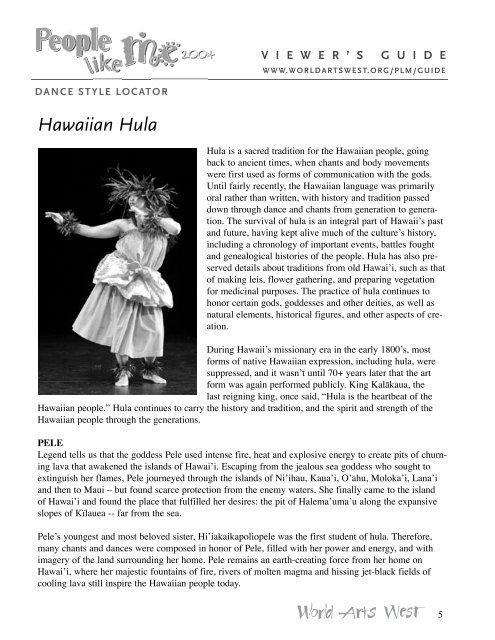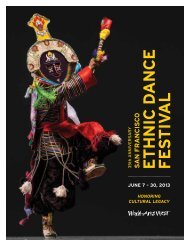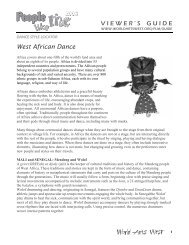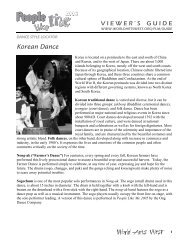South African: Gumboot dance - World Arts West
South African: Gumboot dance - World Arts West
South African: Gumboot dance - World Arts West
You also want an ePaper? Increase the reach of your titles
YUMPU automatically turns print PDFs into web optimized ePapers that Google loves.
V I E W E R ’ S G U I D E<br />
W W W. W O R L D A R T S W E S T. O R G / P L M / G U I D E<br />
DANCE STYLE LOCATOR<br />
Hawaiian Hula<br />
Hula is a sacred tradition for the Hawaiian people, going<br />
back to ancient times, when chants and body movements<br />
were first used as forms of communication with the gods.<br />
Until fairly recently, the Hawaiian language was primarily<br />
oral rather than written, with history and tradition passed<br />
down through <strong>dance</strong> and chants from generation to generation.<br />
The survival of hula is an integral part of Hawaiiʼs past<br />
and future, having kept alive much of the cultureʼs history,<br />
including a chronology of important events, battles fought<br />
and genealogical histories of the people. Hula has also preserved<br />
details about traditions from old Hawaiʼi, such as that<br />
of making leis, flower gathering, and preparing vegetation<br />
for medicinal purposes. The practice of hula continues to<br />
honor certain gods, goddesses and other deities, as well as<br />
natural elements, historical figures, and other aspects of creation.<br />
During Hawaiiʼs missionary era in the early 1800ʼs, most<br />
forms of native Hawaiian expression, including hula, were<br />
suppressed, and it wasnʼt until 70+ years later that the art<br />
form was again performed publicly. King Kalākaua, the<br />
last reigning king, once said, “Hula is the heartbeat of the<br />
Hawaiian people.” Hula continues to carry the history and tradition, and the spirit and strength of the<br />
Hawaiian people through the generations.<br />
PELE<br />
Legend tells us that the goddess Pele used intense fire, heat and explosive energy to create pits of churning<br />
lava that awakened the islands of Hawaiʼi. Escaping from the jealous sea goddess who sought to<br />
extinguish her flames, Pele journeyed through the islands of Niʼihau, Kauaʼi, Oʼahu, Molokaʼi, Lanaʼi<br />
and then to Maui – but found scarce protection from the enemy waters. She finally came to the island<br />
of Hawaiʼi and found the place that fulfilled her desires: the pit of Halemaʼumaʼu along the expansive<br />
slopes of Kïlauea -- far from the sea.<br />
Peleʼs youngest and most beloved sister, Hiʼiakaikapoliopele was the first student of hula. Therefore,<br />
many chants and <strong>dance</strong>s were composed in honor of Pele, filled with her power and energy, and with<br />
imagery of the land surrounding her home. Pele remains an earth-creating force from her home on<br />
Hawaiʼi, where her majestic fountains of fire, rivers of molten magma and hissing jet-black fields of<br />
cooling lava still inspire the Hawaiian people today.<br />
5











